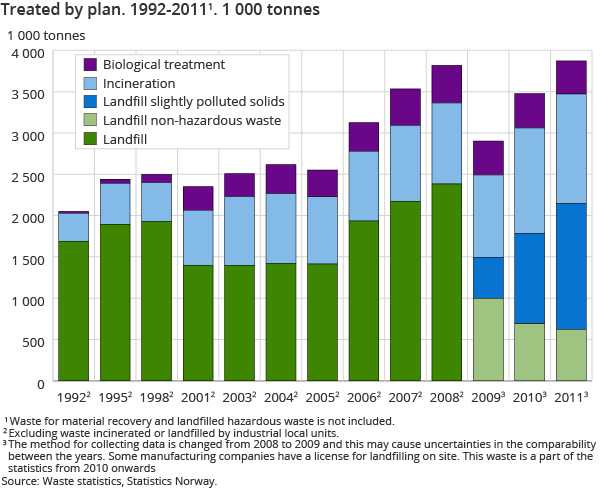Large increase in waste incineration
Published:
Incineration of waste has more than doubled over the last 10 years. In 2011, around 1.3 million tonnes of waste were incinerated – an increase of 14 per cent compared to 2010.
- Full set of figures
- Waste treatment in waste treatment plants
- Series archive
- Waste treatment in waste treatment plants (archive)
The amount of waste composed or used for biogas production has stabilised at around 0.4 million tonnes.
In 2011, around 2.1 million tonnes of waste were landfilled – an increase from 1.8 million tonnes in 2010. Since 2010, industrial landfills were also included in the statistics. The 2011 data show that 0.7 million tonnes of waste were disposed of on industrial landfills.
A large share of the waste entering landfills consists of slightly polluted solids – around three-quarters of the landfilled amounts. Slightly polluted solids are mainly made up of soil, rocks and gravel originating from construction activities. Due to the pollution potential, these solids require separate treatment, but are still not classified as hazardous waste.
The amount of non-hazardous waste being landfilled was about 0.7 million tonnes in 2011.
Methane emissions from landfills constitute around 2 per cent of total climate emission in Norway, or around 1 million tonnes of CO2-equivaltents – a decrease of 0.8 million tonnes compared to 1990.
Waste used as cover material largely reduced
The amount of waste used as landscaping landfills decreased by almost 80 per cent from 2008 to 2011. Such landscaping landfills predominantly consist of slightly polluted solids and other mineral waste, plus smaller amounts of compost, and park and garden waste.
The introduction of the landfill ban in 2009 brought about a decrease of landfill waste, which in turn requires large amounts of landscaping landfills. Simultaneously, the increase in landfilling of slightly polluted solids requires less landscaping landfills. In addition, stricter requirements have been imposed on the types of solids that are allowed to be used as cover material, which apparently has led to a shift from using waste as landscaping landfills to replacing it with cleaner fractions like soils and pebbles.
Contact
-
Eva Vinju
-
Camilla Skjerpen
-
Statistics Norway's Information Centre

